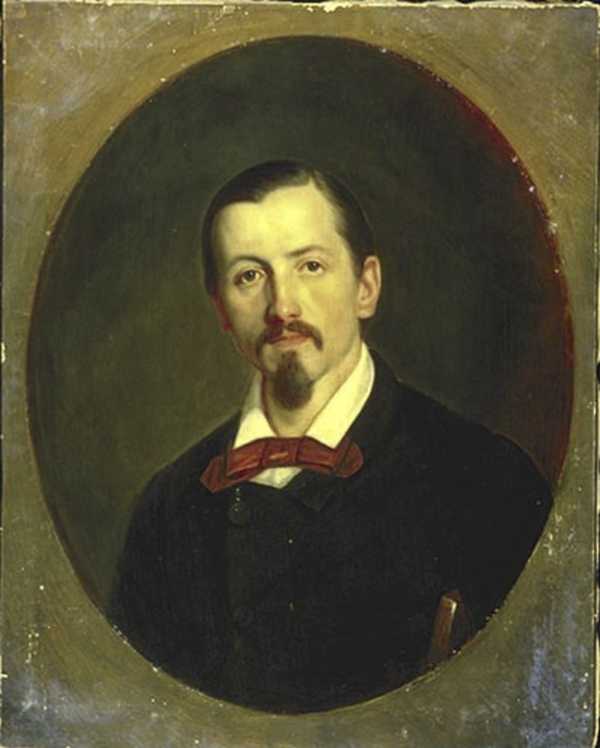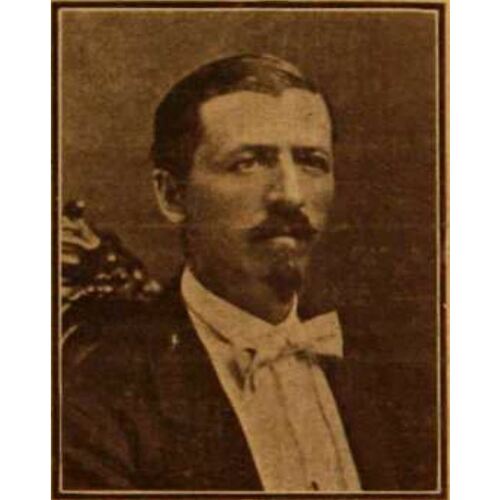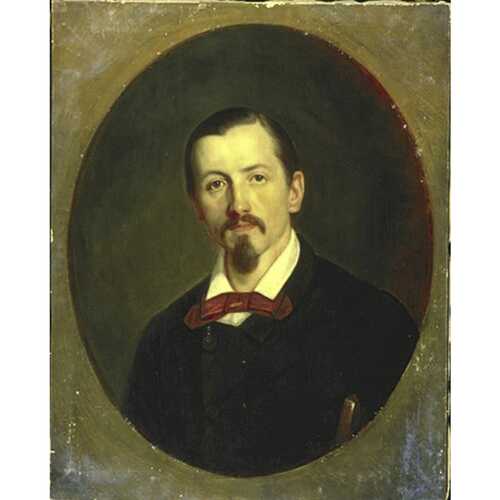
Source: Link
DESSANE, MARIE-HIPPOLYTE-ANTOINE, musician; b. Forcalquier (Basses-Alpes, France), 10 Dec. 1826; son of Louis Dessane and Marie Maurel ; m. in 1847 Irma Trunel de la Croix-Nord by whom he had nine children, with three boys and four girls surviving infancy; d. Quebec, 8 June 1873.
Marie-Hippolyte-Antoine Dessane’s father was a music teacher, and two of his brothers became musicians. They moved to Billom, Auvergne, in 1828, and the father gave Antoine his first music lessons. In 1837 the family went to Paris where Antoine studied at the Conservatoire until October 1841. He is said to have had the sympathy of Luigi Cherubini, the director, who was ordinarily a gruff person. Cherubini called him his “Benjamin” as Dessane was one of the youngest students. Dessane had contact with such fellow students as César Franck and Jacques Offenbach. He studied piano, organ, and violoncello and on two occasions was one of the few successful applicants for classes with limited enrolment. However, he did not graduate or obtain a prize from the Conservatoire. About 1842 Dessane, his father, and his eldest brother set out on a concert tour which lasted a year and a half. It began in France, continued through northern Italy to Trieste, and through Austria and southern Germany. Dessane then taught for a year at the Jesuit college in Billom and in 1845 moved to Clermont-Ferrand. There he associated with a friend of his family, the composer Georges Onslow. In an informal workshop atmosphere they tried out and discussed each other’s compositions and performed music. In Clermont-Ferrand Dessane also taught piano; one of his pupils became his wife.
Living conditions for artists in France after the revolution of 1848 influenced his decision to accept a position as organist and choirmaster at the Quebec basilica, offered to him through a friend of his wife’s and Abbé Pierre-Henri Bouchy of the college of Sainte-Anne-de-la-Pocatière. The Dessanes arrived in Quebec in July 1849. About 18 months later Antoine and his wife, a soprano or mezzo-soprano, took part in a Quebec concert for the first time. He soon rose to a leading role in musical circles and in the mid–1850s led the Société Harmonique. Operatic music was emphasized in its concerts. In 1855 Dessane conducted the first act of La Dame blanche by Boieldieu. In 1857 and 1858 he participated in concerts of the Septette Club featuring excerpts from several Beethoven symphonies and music by Haydn, Rossini, Schubert, Weber, and others. In 1860 Dessane briefly engaged in polemics with Ernest Gagnon* on the theory of plain-chant accompaniment, provoked by the publication of P.-M. Lagacé’s Chants liturgiques, based on the ideas of Louis Niedermeyer, a prominent church musician in France. Niedermeyer’s views did not win much acceptance, but partly as a result of the controversy Dessane resigned from the cathedral a few years later. About 1861 he formed an orchestra of some 60 players, including regimental musicians, but this proved a financial failure.
In September 1865 the Dessanes moved to New York where Antoine became organist at St Francis Xavier Church, connected with a Jesuit institution. In New York he participated as cellist in a series of string quartet recitals but also appeared as conductor and pianist. A highlight was the performance of his Mass no.4. The decline of his health influenced a decision to return to Quebec where Dessane became organist at Saint-Roch Church in November 1869. Once again he assumed a central position in musical life. He founded the choral Société Sainte-Cécile in 1869 and together with Frederick W. Mills served as conductor of the newly revived Société Harmonique.
In 1870 Dessane announced plans for a Conservatoire National de Musique, scheduled to open in November 1871. The school was to offer courses in orchestral playing, theory, and voice and present six concerts each season. It does not appear to have become a reality, but on 28 June 1871 Dessane conducted a concert demonstrating what the conservatory might accomplish. The program was mostly operatic but also included the funeral march from Beethoven’s Eroica and Berlioz’ Les Francs Juges overture. In May and November of that year Dessane presented Adam’s one-act operetta Farfadet and in June 1872 Boisselot’s opéra-comique Ne touchez pas à la reine. Already a sick man, he had to curtail his activities, making a single return to the Saint-Roch organ on 1 June 1873, a week before his death. On 7 Oct. 1872 the leading citizens of Quebec had organized a concert to pay homage to Dessane.
Dessane’s motto was “Alterius non honoris.” A product of the strictly disciplined training of the Paris Conservatoire, he was himself a strict teacher and a hard worker. According to Gustave Smith he raised the level of musical instruction and established the study of solfège in the Quebec convents. Nazaire Le Vasseur* has stated that in contrast to his organist predecessors, who knew little besides plain-chant and operatic music, Dessane introduced the great classical tradition. This view is open to doubt. Dessane’s predecessor as organist of the basilica, Theodore Frederic Molt*, was familiar with classical music and had even paid a visit to Beethoven. On the other hand Dessane’s performances themselves were heavily slanted towards opera. The few pieces of his church music available for inspection appear to be rooted entirely in the early 19th century and reflect little of tradition. All his music examined, whether sacred or secular, shows a theatrical quality, for example, strong dynamic contrasts. The harmonies are euphonious. Within a basically homophonic style the composer knew how to give each vocal part independence. His dance music, for example Le Galop de Pégase, conveys a genuine sense of fun.
Dessane’s more than 50 compositions include about equal amounts of sacred and secular music. The former category includes four settings of the mass (at least two of these with orchestra), several settings each of the Regina Cœli, Dominum Salvum, Ave Maria, and Tantum Ergo as well as other choral settings to Latin words and sacred songs with French texts. The larger instrumental works include a symphony in C, a Suite for orchestra (1863) and a Fantaisie-Sonate for flute and strings (1858). The titles of his instrumental music often refer to Canada: Quadrille sur des airs canadiens (1854), La Québecoise (polka), La berceuse indienne (rêverie for violoncello) and the same is true of such songs as La Mère canadienne (chant patriotique, by Emmanuel Blain de Saint-Aubin) and three to words by Octave Crémazie: Le chant des voyageurs, Chant du vieux soldat canadien, Hommage à la France (chant canadien). Some of these songs enjoyed a measure of popularity. To the list of compositions should be added a didactic work on the theory of orchestration, written in 1869. Dessane set up his own lithographic workshop in which he prepared reproductions of some of his works.
Dessane’s contribution was reinforced by his wife, who is said to have introduced the French romance to Quebec (“ou pour mieux le dire le chansonette de bon ton,” G. Smith), and at least three of their children became musicians.
Catalogue of Canadian composers, ed. Helmut Kallmann (Toronto, 1952). Sœurs de Sainte-Anne, Dictionnaire biographique des musiciens canadiens (2e éd., Lachine, Qué., 1934). Helmut Kallmann, A history of music in Canada, 1534–1914 (Toronto and London, 1960), 91–92, 93, 106, 124, 126, 181, 188. Nazaire Le Vasseur, “Musique et musiciens à Québec,” La Musique (Québec), I (1919), 126 – II (1920), 123. Irma Michaud, “Antonin Dessane – 1826–1873,” BRH, XXXIX (1933), 73–76; “Madame Dessane, née Irma Trunel de la Croix-Nord, 1828–1899,” BRH, XXXIX (1933), 76–79. Gustave Smith, “Du mouvement musical en Canada,” L’Album musical (Montréal), 1882.
Cite This Article
Helmut Kallmann, “DESSANE, MARIE-HIPPOLYTE-ANTOINE,” in Dictionary of Canadian Biography, vol. 10, University of Toronto/Université Laval, 2003–, accessed December 12, 2025, https://www.biographi.ca/en/bio/dessane_marie_hippolyte_antoine_10E.html.
The citation above shows the format for footnotes and endnotes according to the Chicago manual of style (16th edition). Information to be used in other citation formats:
| Permalink: | https://www.biographi.ca/en/bio/dessane_marie_hippolyte_antoine_10E.html |
| Author of Article: | Helmut Kallmann |
| Title of Article: | DESSANE, MARIE-HIPPOLYTE-ANTOINE |
| Publication Name: | Dictionary of Canadian Biography, vol. 10 |
| Publisher: | University of Toronto/Université Laval |
| Year of publication: | 1972 |
| Year of revision: | 1972 |
| Access Date: | December 12, 2025 |




